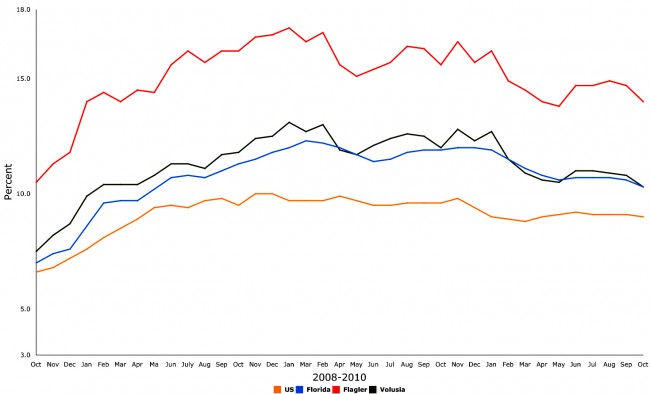
Almost 1 million Floridians are still unemployed, and well over 1 million are unemployed, under-employed or too discouraged to look–or be counted in the labor force–but figures improved slightly in October, with the unemployment rate falling to 10.3 percent statewide, the lowest level in 18 months.
Job creation is not significant: just 9,500 jobs were created in October, for a total of 93,000 in the last 12 months, still well below normal job-creation activity. But the state’s new, stringent requirement for people hoping to collect unemployment are paring the jobless rolls by discouraging workers from applying in the first place.
In Flagler County, the September unemployment rate was revised upward by a decimal point, to 14.7 percent, but the October figure was down sharply, to 14 percent, a level last reached, briefly, last April, and also in march 2009. The county’s labor force has also shrunk by 1.6 percent when compared with its size a year ago.
Still, the overall trend is more positive than it’s been for months–if not a couple of years–and more good news may be ahead, as fewer people are filing for unemployment claims nationally. The four-week average for those initial claims fell to 388,000, best since April, while the nation has been adding jobs for 13 straight months–though still not enough to outdo the 125,000 jobs a month the economy must create just to keep up with normal increases in population and labor force.
Professional and business services, especially administrative and waste services, added the most jobs during the month, with 10,900 (or a 1 percent increase for that sector). For the first time in months, government jobs, especially at the local level, increased, with 6,900 new jobs added, 6,800 of them at the local level. Federal jobs continue to decline in the state, with a loss of 800.
Other sectors posting gains include wholesale trade (1,900 jobs), information (1,000), and health care (1,300).
On the losing end, leisure and hospitality, which had been a job creator for months, lost 2,800 jobs. Construction lost 4,800 jobs. Transportation, warehousing and utilities lost 1,800, and education services lost 900.
For all the improvements in the jobs picture, Flagler County’s 14 percent unemployment rate is still second-worst (and the worst when rated by metropolitan areas), behind Hendry’s 16.1 percent. Hernando is in third, at 13 percent. The counties with the lowest unemployment rates are Liberty and Monroe (6.3 percent), Walton (6.8 percent), Okaloosa (7 percent) and Lafayette and Alachua (7.4 percent).




























PalmCoastPioneers says
‘…An approach to a New City: Palm Coast….’ 1972
Below is an excerpt from Page 144 of the 1972 publication of ‘..An Approach to a New City: Palm Coast..’ by Dr. J. Norman Young, Father of Palm Coast.
Therein it says ‘The Palm Coast Project’ was designed almost like a FIAT.
Because of this hopefully the city or someone will *network* with the FIAT Dealerships and hopefully FIAT / Chrysler.
Just as Renault had ‘Le Car’ maybe something like that for Palm Coast with FIAT / Chrysler .
Hopefully someone will *network* with Chrysler / Fiat and start something for jobs, etc., here. Anyone have any ideas / suggestions to perhaps start to cultivate a relationship with Chrysler / Fiat ?
A Red FIAT can be seen being raffled off in Palm Coast. Tonight it was in the Palm Harbor Shopping Center. We donated $10. for the Toys for Tots Program raffle of the H O T Red Fiat !
Page 144:
shows in a very limited way how one environmental problem can lead to or cause another problem in a different but related sphere of influence. This is true whether one traverses radially or concentrically on the chart. Superimpose on this two dimensional scheme a third plane of flora-fauna and the complexity increases geometrically. Perhaps that is why lasting solutions to existing ills have been prohibitively expensive or virtually imossible. Prevention, therefore, appears to be the only viable approach. Solutions to the effects of man’s actions must be ascertained in the planning stage and must be given priority in the decision-making process.
Psychosocial Pollution
At Palm Coast we persist in a design that is almost a Fiat: 2.7 dwelling unite per acre. Thus, as was earlier stated, we will have a city larger than Detroit or Philadelphia, with the density of , say, Beverly Hills, California, rather that the malignant densities characteristic of the asphalt and concrete jungle. Why? Because ultra high density is cancerous. We are sure that many will quarrel with this statement, citing locales here and there where satisfaction exists in spite of ostensible crowding. Mabye it is as Deeevy points out, ‘the mass of man, although increasingly affected with mental discomfort, do not see themselves as overcrowded.’ It is better to state that we deal with probability of sociopathic behavior. ( It is similar to the tnedentious arguments about the facts of cigarette smoking induced cancer–there is always that irritation ‘Oh, my Uncle Louie has been smoking for ninety years and is as healthy as a horse.”) In any case, the preponderance of psychological , statistical, research and lay observations leaves us with the same funereal conclusion’ crowding is an excrescense that society can ill-afford.
The psychological results of density–how does one begin analyzing them? The senior author is now engaged in a monograph on the subject. ( Stochastic Processes and Density-Induced Deviant Behavior), and therefore is aware that the subject is broad and that he can present in this medium only a few of the references. It has been in the literature a long. time. For example, shall we begin the disquisition with Sir R. W. Rawson’s 1839 (circa) seminal paper6 published by the Journal of the Statistical Society of London? Or, jump about a century to R.D. McKenzies’ “The ecological Approach to the Study of the Human Community” 7 published in 1925 , which formed the basis of the Elliott and Merrill chapter
Page 145